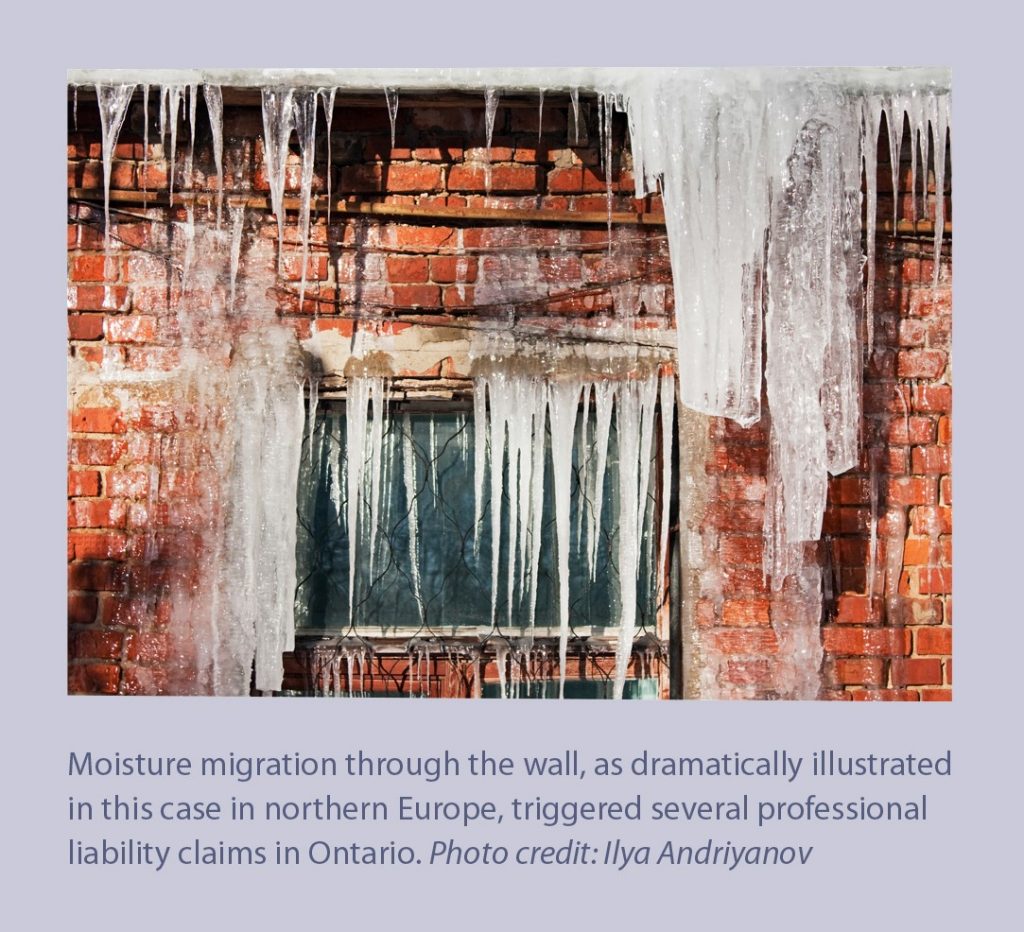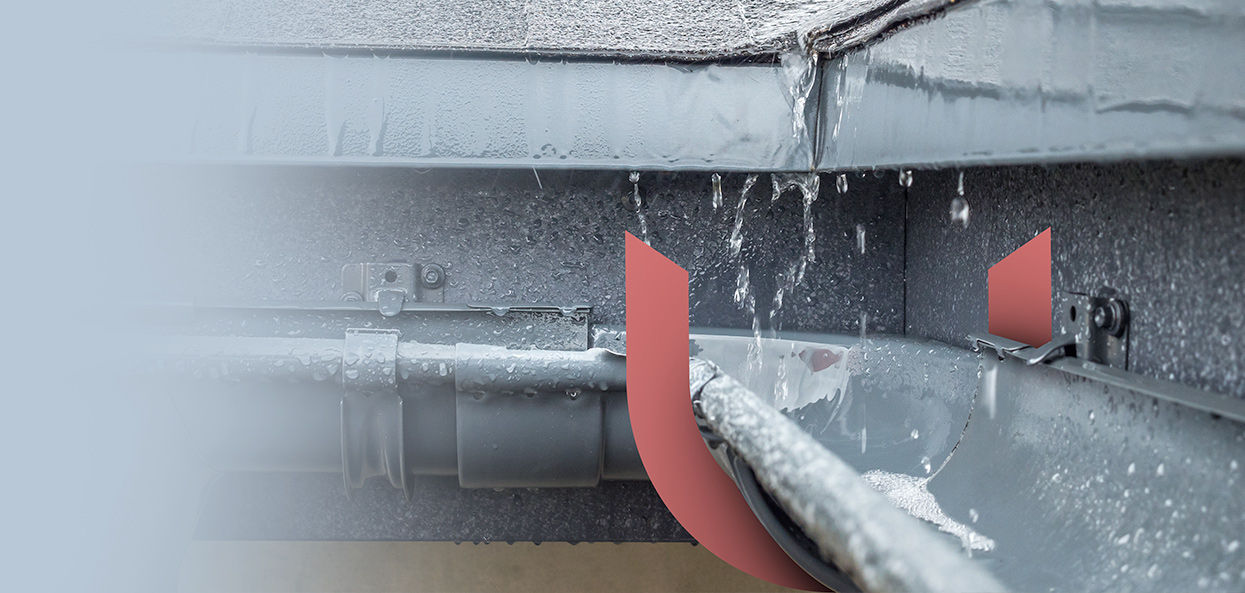This is an abbreviated version of an article that was published in the Fall 2018 edition of Pushing the Envelope Canada, which is printed twice per year by Matrix Group Publishing Inc. for the Ontario Building Envelope Council. Portions of the original article have been reprinted with permission and may not be reproduced without prior written consent. To read the original article in full, please go to https://www.obec.on.ca/pte-newsletter.
In a recent research project, we found that water damage to the building enclosure was the leading trigger of professional liability claims against Ontario architects. This was the first time that anyone has measured patterns in such claims, and we were struck by the fact that all building types were affected, in all regions of Ontario, and that liability was often shared with building science consultants.
Readers can access the Claims Experience Workbook: Lessons from a review of professional liability insurance claims. Published in early 2018 (by Pro-Demnity and the Ontario Association of Architects), the Workbook fully documents our findings and highlights actions that architects can take to manage their
risks – some of which have implications for building science consultants.
Because the Claims Experience Workbook mentions engineers, and others, frequently within its pages, I’d
like to see non-architects read it, in its entirety. Here, I highlight the types of water-related claims that arose most often; how “what failed” varied with building type; and where building science consultants were either part of the problem or could be part of future solutions.
I then suggest how continuing education for mid-career practitioners might respond to the patterns we saw in the claims. Finally, I recommend two additional items to study – right now – to help with day-to-day decisions about the design and construction of better building enclosures.
What Happened?
Because Pro-Demnity Insurance provides the mandatory professional liability insurance coverage for all architectural practices in Ontario, we were able to look for patterns among all of the claims that were lodged against any Ontario architect, during a recent five-year period. We found that water damage was “the biggest of the big” trigger of claims, that building science consultants were found liable (alongside the architect) in roughly 20 per cent of enclosure-related settlements, and that roofs, walls, windows, and foundation walls were each affected, to varying degrees.
From the individual building owner’s or occupant’s point of view, each claim arose because a water-related event incurred significant un-planned costs and caused headaches. In a few cases, an entire building had to be re-clad. In many more, remedial measures were substantial and took years to complete. Each claim was unique, and most arose because of a cluster of errors or omissions, large or small, perceived or real. In Ontario, we have not (yet) experienced a BC-style leaky-condo crisis. But make no mistake, over the course of five years at numerous sites across Ontario, significant water damage to an enclosure actually happened.
Among the factors frequently at play were:
• Fundamental choices at the earliest stage of design;
• The selection of products or systems;
• The quality of the whole design team’s drawings and specifications;
• Oversights during field review or third-party inspection; or
• The acceptance of construction-phase substitutions of non-specified products.
To the extent that consultants professing advanced knowledge of the science of the building envelope were involved in any of these activities, they were called to defend their actions. As to the physical facts, claims involving water damage to the exterior wall were the most costly, if not the most frequent. Next were roof leaks or condensation (sometimes due, in part, to insufficient ventilation).

Broken pipes in under-insulated or unheated spaces made up another class of mishap. Below-grade leaks, poorly planned (or constructed) site drainage, and poorly planned (or constructed) interior floor drainage also gave rise to claims. Claims that a window failure involved an architect were remarkably few.
The Claims Experience Workbook suggests some very general risk management strategies to address each of these matters.
Different Issues for Each Building Type
Assembly buildings and office buildings were more often affected by roof failures and leaky pipes than by wall failures. These were mostly low-rise buildings with a variety of roof shapes and roofing systems, and plenty of uniquely-configured roof-to-wall junctures. In multi-unit residential buildings (MURBs) and hotels (whether low- or high-rise), the inverse was true: walls were most often affected. Face-sealed exterior insulation finishing systems (EIFS), pre-cast concrete panels, and brick and wood cladding were all featured in one or more of the claims we examined. In single-family houses, costs went mainly to settle wall failures, but roof failures were as numerous.
ARCHITECTS ARE REQUIRED to meet an extraordinary number of professional challenges in practice. It is unreasonable to assume that every architect is equally equipped through education and experience to deal with all of these.
Pro-Demnity’s risk management advice to architects has regularly included the benefit of establishing and maintaining a quality assurance/ quality control program for the practice. Many such programs include the participation of additional specialists to supplement the architect’s own expertise.
Often, claims that arise against architects involve design decisions and “gaps” in documentation and specifications. In the intense spotlight trained on the architect facing a claim, it has often become apparent that many “errors” or “oversights” might have been avoided if the work had been subject to a quality assurance review or collaboration with another professional who brought different perceptions and expertise to the design as it was being developed.
The plaintiffs who lodged the claims also varied markedly with building type. For instance, MURBs were distinguished by a high number of claims lodged against consultants by condominium associations (or unit owners), regardless of the fact that these entities were not the architect’s or specialist consultant’s original client. Purchasers frequently alleged a designer or field inspector was liable, regardless of who was originally contracted to whom.
The Claims Experience Workbook discusses these patterns more thoroughly and suggests building-type-specific risk management priorities.
Building Science Consultants: Part of the Problem or Part of the Solution?
Enclosure design consultants, roof inspectors, and Tarion Bulletin 19 field review consultants each figured in claims where architects were also named. MURBs were the setting of several of these claims, as were public buildings of various types, but single-family houses were not exempt. Icicles, parapet leaks, missing scuppers, so much mould that the wall framing begins to rot – specialists in this business will recognize the potential consequences of poorly designing or poorly constructing a building enclosure in Ontario’s demanding climate. One spectacular failure of a vegetated roof on a single-family house was even featured in the pages of the Toronto Star newspaper.
While they have shared in the problem, clearly building science consultants have a significant role to play in developing future solutions.
“There’s a lot to know, and we practice in one of the fastest-paced construction environments in the world. I strongly suggest we hold hands and work together.“
We were troubled to see, however, that appropriate insurance of all defending parties was not in place in
all of the claims Pro-Demnity defended. In Ontario, both the Architects Act and the Professional Engineers Act require any firm that is giving advice about the design or construction of a building (and this certainly includes the enclosure) to carry professional liability insurance. In the Claims Experience Workbook, therefore, the OAA and Pro-Demnity strongly reinforce these requirements, reminding architects to help protect the best interests of the public by confirming that any building science consulting firm with whom they contract carries appropriate levels of professional liability insurance.
In-Service (Re-)Training Needed
In a world where new products seem to emerge nearly every day, where the pressure to build at the utmost speed is unrelenting, and where hailstorms, rainfall, and high winds are becoming more frequent and more extreme, it seems to me that continuing education for all building-enclosure professionals is in order. While just a small percentage of Ontario’s 1,500 architectural firms were named in the claims we reviewed, the pressures that led to claims exist for everyone.
I want to see robust continuing education that is multi-disciplinary and is, at least in part, building-type specific. It should treat our shared duties to the public as a central theme and express confidence in our shared ability to uphold it. Climate-appropriate design also ought to be a featured topic. (Detailing in North Bay should – to a degree – emphasize somewhat different concerns than detailing in St. Catharines.) Climate-change resilience is clearly another urgent concern. (Extremely high winds during the spring of 2018 produced quite a bit of roof repair business; but would it not have been preferable to make the roofs more wind-resistant in the first place?)
One of the most exciting building science curricula I’ve seen for architects featured the whole host of actors in the construction process at the podium: building science professionals, architects, insurers, builders, and others.
For architects, continuing education is best when there is more emphasis on creative synthesis of the whole design than on deep analysis of its parts. We can always use reinforcement about the management and resolution of the full range of perspectives (builder, inspector, designer, occupant, operator, and so on). Tactile evaluation of materials and systems is always appealing, as are detailed case studies.
Earlier this year, I thoroughly enjoyed my first-ever trip to the Canadian Roofing Contractor’s Association’s ROOFTech show, where they build stuff, full-scale. If you’re an architect like me, who has never been, go! If you’re a building science professional, encourage the architects you know to go. Finally, I think we need to design continuing education for more than one level of learning. This is very challenging and needs some shared thought. I’m excited about the new modules being developed to support seekers of the OBEC Building Science Specialist designation, and I imagine great potential for them to be part of a larger
system which could help serve an even larger audience.
Readers’ Choice
For now, as a result of what I saw in the insurance claims, I recommend the following web-based video and book to anyone with a professional interest in making better buildings in Ontario.
First, consider watching Great Lakes, Global Warming, and Crazy Weather (original air date: September 13, 2017), presented by TVO’s The Agenda. It’s 30 minutes well spent. Climatologist David Phillips and Gail Krantzberg, professor of engineering at McMaster University, discuss the health of the Great Lakes, the economics of the cross-border region, and building for resilience. They suggest that better roofing and storm drainage are connected to improving ecosystem health, trade, and community safety. Now, let’s hear from the architects and consulting engineers!
Second, Brian Palmquist’s An Architect’s Guide to Construction, Tales from the Trenches, aims to increase
the effectiveness of everyone involved in the construction process. Although Palmquist set out mainly
to provide intern architects with guidance and inspiration, I also found this book (despite my many years in practice) an inspiring read. The commentary is informed by extensive knowledge of professional liability claims in British Columbia and from the author’s direct experience as consulting architect, building science consultant, and contractor. Nevertheless, the approach is upbeat and hopeful. I’ve seen nothing else in print like it (published in Vancouver, in 2015 by Quality- by-Design Software Ltd., available through Amazon).
While architects and building scientists can jointly be proud that the overall cost of resolving errors and
omissions claims has been, to date, but a fraction of the value of construction starts in Ontario, we can – and ought to – continue to strive to do better. Should water-related damage to the building enclosure be the most significant single driver of professional liability claims against architects? Or might that be avoidable?
To the individual building owner, no leak is acceptable. To the consulting architect or engineer, no claims-
resolution process is enjoyable, either. Beyond mere avoidance of trouble, the higher shared goal, really, is more comfortable, durable, energy-efficient, and resilient buildings – buildings that truly benefit from the attention and skills of committed design professionals. I hope that the Claims Experience Workbook will help serve that goal, starting now. In the future, I hope that the Ontario Building Envelope Council and the OAA will continue to work together to enhance Ontario’s continuing education programs for all building envelope professionals.
This is an abbreviated version of an article that was published in the Fall 2018 edition of Pushing
the Envelope Canada, which is printed twice per year by Matrix Group Publishing Inc. for the Ontario
Building Envelope Council. Portions of the original article have been reprinted with permission and may not be reproduced without prior written consent. To read the original article in full, please go to https://www.obec.on.ca/pte-newsletter
Contributing Author: Barbara Ross, M.Arch., CUT, OAA, FRAIC

Barbara Ross is the principal of The Research in Architecture Studio. A particular interest is understanding and explaining emerging “ways and means” that aim to lower the loads that mid-sized public-sector buildings impose on the natural environment.
Quoting Barbara:
“Asking an open question may feel risky – but it is how we learn. The evidence that The Studio
will uncover should be eye-opening, and may challenge existing assumptions. In all cases, but
particularly when researching a “green” or “ecological” topic, we try to move the discussion
from dogma to data.”
This approach is exemplified in Barbara’s work with Pro-Demnity – assisting with a number of important investigations, including the science associated with vegetated (green) roofs, and an understanding of concrete failures in the presence of pyrrhotite, which has triggered significant claims in Quebec and elsewhere.
Barbara was responsible for the milestone research into Pro-Demnity’s claims experience over a five-year period that is summarized in the Claims Experience Workbook and the accompanying Checklists & Worksheet. Starting in 2016, Barbara delivered over 24 Risk Education events to Ontario architects reporting on the findings from the research and, through “Workbook Workshops,” helping prepare participants to apply the lessons to their own practices.
Barbara can be reached at:
The Research in Architecture Studio
T: 905-823-8784 E: rosstrum@bell.net

